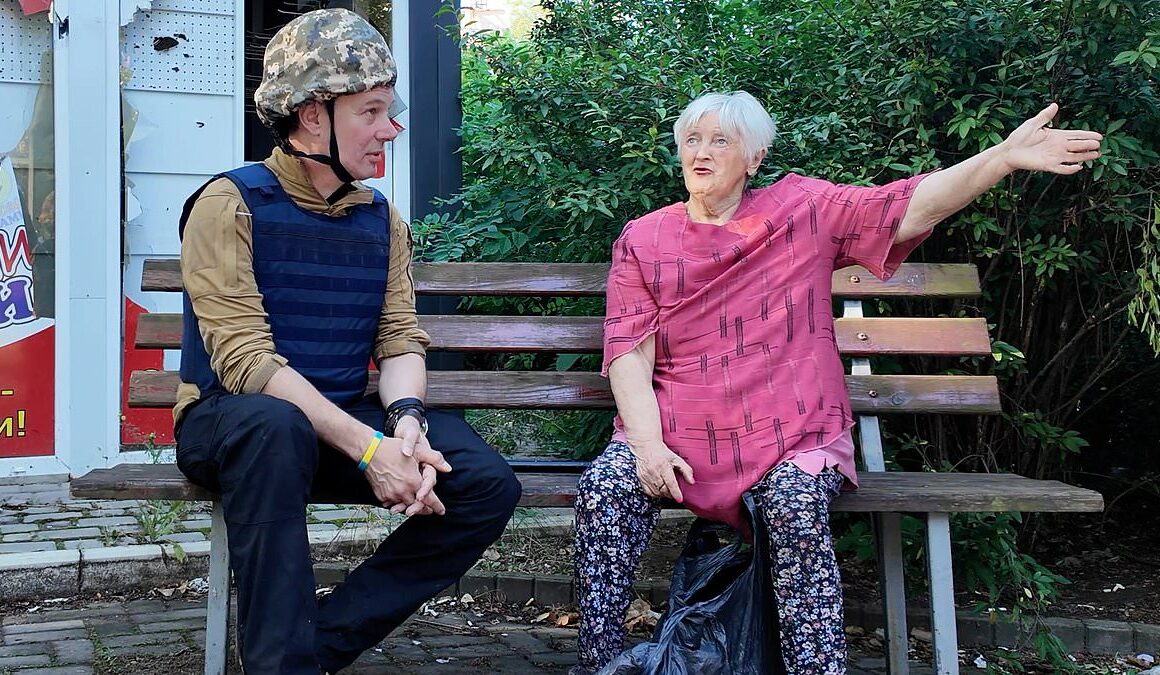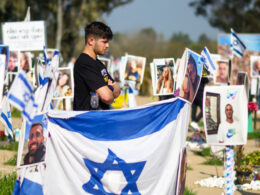New York, New York, it’s a hell of a town — as we’re about to find out. But the New York we’re approaching is not the New York you know.
It’s 6.15 on an exquisite midsummer morning and we are being driven as fast as possible into the rising sun by a Ukrainian special reconnaissance unit. Our destination is a small city in Donetsk Oblast that shares its name with the Big Apple.
There the similarities end. The soundtrack to our New York journey is provided not by Sinatra but a drone alarm, with its frantic warning beeps, as a Russian target-acquisition unmanned aerial vehicle (UAV) closes in on our convoy.
The little black box has two antennae and fits into the palm of the hand of the soldier sitting in the front passenger seat of the pick-up truck we’re travelling in. Its job is to detect and analyse the electronic footprints of enemy drones flying within a six-mile (10km) radius.
And so, for the last mile of this otherwise charming country lane, flanked by birch trees and wildflowers, the red plastic exclamation mark on the box’s fascia has been flashing in time with the beeps.
A warning message has also appeared on the box’s digital display, adding to the sense of impending doom.

The soundtrack to our journey to New York, Ukraine was frantic warning beeps from a little black box with two antennae that fits into the palm of the hand of the soldier sitting in the front passenger seat

Daily Mail journalist Richard Pendlebury and guide Lieutenant Oleh in the Ukrainian town of New York

A collapsed building in the town of New York in Donetsk Oblast, Ukraine

A shop destroyed by Russian shelling in New York, Ukraine on July 3
The soldier in the passenger seat — our old friend Lieutenant Oleh — consults the device and informs the driver, ‘SupaCam directly overhead now’.
A SupaCam is a type of Russian drone that provides real-time footage for Putin’s artillery and kamikaze drone operators. This is not good. A bitterly contested no man’s land is less than two miles away and ours are the only cars on the road.
We are a mouse under a hawk. The sun is still low but my palms are sweating.
The battle for New York is about to begin. We do not know it yet, but Mail cameraman Jamie Wiseman and I are attempting to enter Ukraine’s Little Apple, only hours before the Russians break through the Ukrainian lines and reach the city limits.
‘Within a month or two, New York will be destroyed like Bakhmut,’ we have been told by our military escort. ‘Given its name, I’m sure the Russians will take a particular pleasure in doing so.’
That could prove to be a conservative estimate, as we will see.
Meanwhile, we are here to witness — and film for the Mail’s Frontline Ukraine YouTube channel — what life in New York, Ukraine, looks like on the verge of Armageddon.
The city was established in the mid-19th century. The reason for its name is unclear, though it’s likely that among the founding fathers were former inhabitants of the original New York, USA. Certainly, by the end of 1890s the city had a large population of German-speaking Mennonites, an Anabaptist Christian sect which had also set up communities on the American eastern seaboard.
The small city prospered and became a centre of both industry and culture.
At one time, New York possessed the third-largest bookshop in the whole of the Russian empire. But the 20th century brought problems for New York — and the Mennonites in particular. Imperial Russia and Germany were on opposite sides in World War I. Worse came when Hitler invaded the Soviet Union in 1941.
Stalin deported the German-speaking New Yorkers to Soviet Asia and in 1951 the Soviet authorities changed the name of their former home from New York – then, as now, the capital of Western capitalism — to ‘New City’. And so it remained for 70 years.
But world events refused to leave the city in peace. In May 2014, Russian-backed separatists briefly captured New York and nearby Toretsk. New York continued to be shelled long after it was liberated by Ukrainian forces, and almost 20 of its citizens were killed.

We were attempting to enter Ukraine’s Little Apple, only hours before the Russians break through the Ukrainian lines and reach the city limits. Pictured: Jamie Wiseman

Smoke rising over the town of New York, which until the end of last month was one of the quietest sections of the front line
Amid this constant threat, the locals reinstated their historic connection with the Big Apple. In July 2021, the city’s name was officially changed back to New York; an act of defiance towards Russia and Putin in particular.
Since then, there has been a New York Literary Festival and even a New York Marathon, both taking place in the depths of the Donetsk Oblast.
But now the Russians are on New York’s doorstep once again.
***
A few minutes before 3am, on the morning of our journey to New York, I wake with a start. It’s a warm night and the window by my bed is slightly ajar. Beyond it lie fields and rolling hills, and while the frontline is close enough for the crash and boom of artillery to be heard round the clock, at this hour the guns are quiet.
I had been roused by a distinct buzzing sound. At first, I tell myself it’s only a motorbike or some other vehicle approaching along the road that runs past our temporary home. But the noise remains the same, neither closer nor further away and I have to accept that it’s the horribly familiar whine made by a loitering drone. I’m sufficiently alarmed to leap out of bed, slip on shorts and shoes, switch off my phone — lest it give me away somehow — and wonder what to do next.
I’m sharing my lodgings with Ukrainian soldiers and there is a café below my room. A number of such places have been targeted by Russian missiles.
For several minutes I sit in the dark, listening, until whatever is making the sound literally buzzes off.
I wonder whether the drone’s pilot has been counting the number and type of vehicles parked outside and, if so, an Iskander missile will be arriving shortly. Nothing happens, of course, or I wouldn’t be writing this. Maybe, like everyone else here, I’m suffering from drone neurosis.
Later, when I recount the experience to a soldier, he shrugs and suggests that a local Ukrainian unit was testing a drone equipped with a night-vision camera.
‘They shouldn’t have done it outside your window, but, you know, there’s a war on and you can’t always please the neighbours,’ he says.
But by then, we have experienced the real threat, on our journeys to and from besieged New York.
***
Sunrise is at 4.32am. It’s a beautiful morning and the dawn casts a honey glow over the rolling Donbas Hills.
The vast wheat fields south of the battered town of Kostiantynivka glow amber and after the last manned checkpoint, the road runs straight and empty while the sky above is a faultless blue.
At 6am, the drone alarm comes to life. The Ukrainians have a phrase for what this means: ‘The sky is dirty.’
No one else is on the road now except our two vehicles. The last time Lt Oleh led a patrol to New York, earlier this year, his Mitsubishi pick-up truck was hit by two Russian kamikaze drones. He and his comrade escaped with their lives only because the Russian drone pilot aimed for the tailgate rather than the cab. On that occasion, Oleh was not equipped with a drone-detector and you can’t hear a UAV approach above the noise of a vehicle engine.
What is the protocol for when a drone is obviously hunting us, I ask. ‘We drive off the road into cover, then we disembark and scatter,’ I’m told.
Our speed has increased.
We cross a newly dug trench-line that is bisected by the highway. If the Russians ever reach this far, New York will have fallen. Further on, we come upon a junction that has been straddled by two heavy howitzer shells, and turn east down a sun-dappled lane. Eventually — the beeps unceasing — we enter the deserted outskirts.

A quiet street in New York, Ukraine. The last time our guide Lt Oleh led a patrol to New York, earlier this year, his Mitsubishi pick-up truck was hit by two Russian kamikaze drones

A severely damaged building with smashed windows and crushed balconies in New York, Donetsk Oblast
The windows of New York’s main church, the Temple of the Holy Spirit, have been blown out by the Russian bombardment and the crash of artillery competes with the church clock’s chiming of the quarter hour.
A sign on the presbytery gate advertises local honey which can be delivered ‘to anywhere in the city’. No longer, one assumes.
But where are the New Yorkers? We have been told that there are still several hundred left from a pre-invasion population of 10,000.
The first we see are two old ladies wearing colourful headscarves, walking by the roadside. One is carrying a large bunch of white hydrangeas. No, they say, they have no time to talk to us, and hurry off.
The same thing happens with another pedestrian. He is too busy to stop, he explains, because the frozen fish he is carrying will melt if he does.
They are not hostile, just nervous. The Russians are nearby and the Ukrainian patrol will attract their attention.
Then we meet 77-year-old Valentyna. She is on her way, on foot, to find bread and is pitifully grateful to talk to strangers from the world outside war-torn New York.
In fact, she bursts into tears, exclaiming: ‘God, how tired we are of all this! Please push these Russians out so that we may live in peace here!’
She says that her fellow New Yorkers have received no recent humanitarian aid. But she will not leave: ‘My pension is small and where to go? To sit with cap in hand and beg?’ Her only son is in what is left of occupied Mariupol.
The day before we met, she heard a jet fighter overhead and bombs or shells falling so she took shelter in her basement, as she often has to do. ‘As soon as the shock wave hits, everything flies — including roofs.’
She refuses our offer of a lift because ‘I need to walk since we are still sitting in our homes all the time’ and we part with her blessing: ‘Guys, live healthy, love (someone). I wish you have a beautiful woman.
‘But choose good women, because now there are different girls… Well, that’s it. Goodbye.’
And off this indomitable New Yorker goes into the sunrise, in search of the bare essentials of her increasingly constrained life.
We drive on, through Midtown. We pass a gym, beauty parlour and petrol station, all smashed and empty, then that most New York of all businesses, a deli and bakery, intact but shuttered.
On the classical frontage of the Soviet-era town hall, a large piece of graffiti says ‘I (heart) NY’, as you might see in Brooklyn or the Bronx. In a square off Freedom Street, another old woman is sitting on a bench. ‘Why should I leave here?’ Luba demands. ‘Ukraine is my Motherland?’ As we chat, more artillery crashes across town.

A tank on the roadside near the town of New York in Donetsk Oblast, Ukraine

An elderly civilian being rescued in the town of New York, Donetsk Oblast, Ukraine
Small-arms fire can now be heard – probably Ukrainians trying to shoot down the SupaCam. The time has come to leave. Our exit is even more stressful than our entry.
‘Russian (kamikaze) drone, range 6km and closing,’ Oleh reads off the little black box’s display screen, as we speed back up the lane towards the highway. Then: ‘Kamikaze drone range now 3km.’ It seems the time has come to drive into cover.
But the Russian drone comes no closer and we reach what passes for safety in Donbas.
Thirty-six hours later and many hundreds of miles to the west, we receive shocking news. A powerful Russian glide bomb has hit central New York, killing four of its remaining residents and injuring several others. I think of Valentyna and Luba.
The following day, the Russians punch through the nearby Ukrainian defences to within a field’s width of the Little Apple.
The Battle for New York has begun.
n See accompanying exclusive film on the Mail’s Frontline Ukraine YouTube channel.












